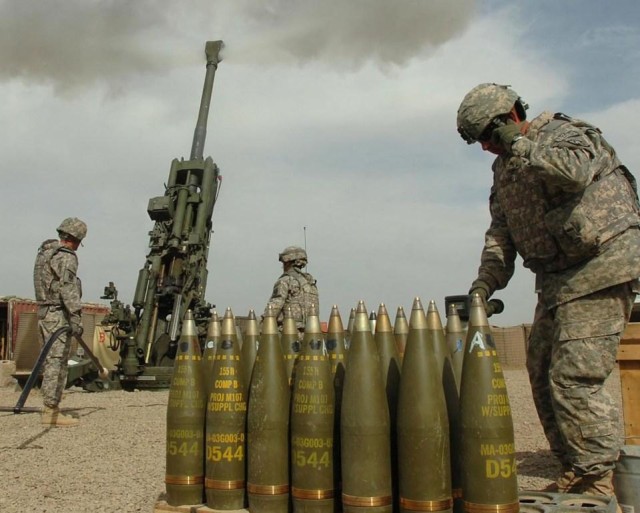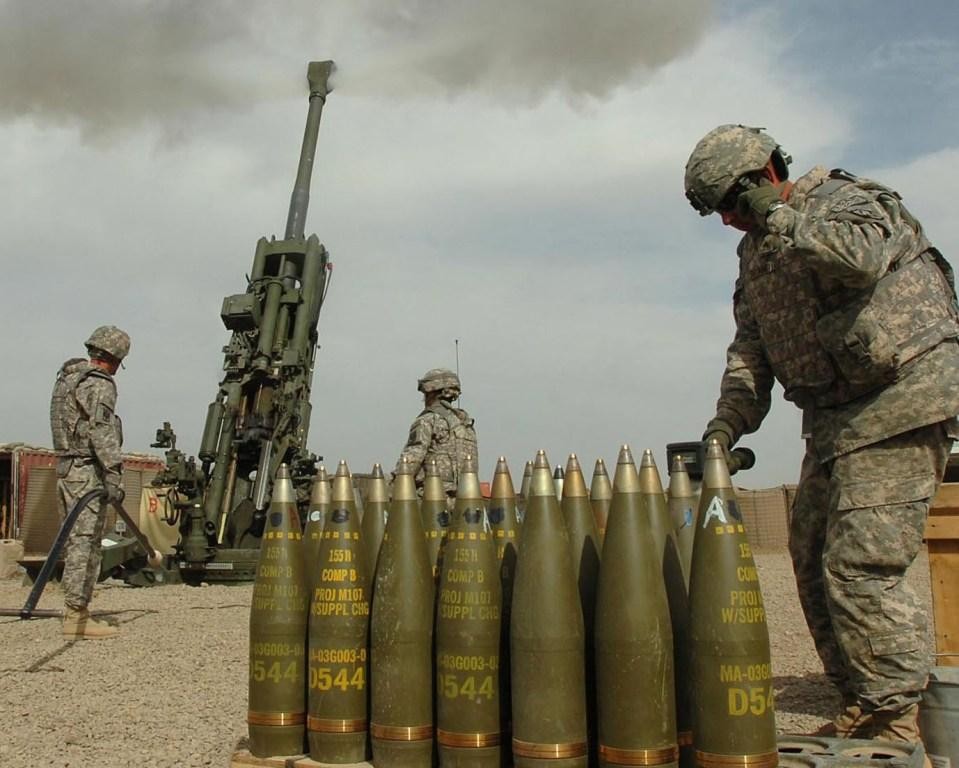PICATINNY ARESENAL, N.J. -- A lot can happen during the course of a phone call.
On Jan. 14, 2005, Tom Coradeschi placed a phone call to Robert Pinto, triggering a conversation that would give impetus to a revolutionary advancement in artillery.
Coradeschi had never met nor spoken with Pinto. But Coradeschi's boss, then Lt. Col. William Cole, had worked with Pinto before and suggested that Coradeschi call him. Caradeschi is the Systems Engineering Lead for the Excalibur precision-artillery program with the Armament Research, Development and Engineering Center, known as ARDEC.
"We had worked with him on a concept demonstrator fire control system when he was Major Cole, the Project Officer for the Digitized M119A1 Howitzer," said Pinto, an engineer in the Fire Control Systems and Technology Directorate at ARDEC, at Picatinny Arsenal. "He was familiar with the fact that we could rapidly turn things around."
Cole and Coradeschi were with the Excalibur project office that was working to deliver a revolutionary advancement intended to bring precision to cannon artillery.
Having the precision fires capability embedded with artillery units, which are usually close to units engaging the enemy, would significantly boost precise strike capability.
Cannon artillery at the time was too blunt an instrument. Cannons achieve relative accuracy based on calculations derived from data such as the howitzer's location, wind speed and direction, target location and other factors.
Once the round is fired, slight differences between the calculated data and the actual conditions over the long course of travel in a typical 155mm round may result in dispersions of tens or even hundreds of meters.
Commanders needed more precision to avoid casualties among civilians who might be in the vicinity, or to reduce risk to friendly forces in a close fight.
Using Global Positioning System technology to provide guidance and auto-deploying, free-spinning base fins and canards to make a round operate more like an aircraft, Excalibur Block IA would sail farther and correct to a position almost directly over a target, then drop to within ten meters.
Excalibur has been loosely described as a "smarter" artillery round, or in the words of one U.S. Soldier, "It turns an artillery cannon into a sniper rifle."
When Coradeschi called Pinto in January of 2005, the timeline to deliver the Excalibur round to U.S. forces was too slow for overseas commanders.
Their objective was to examine the feasibility and, possibly, a path to deliver Excalibur ahead of its programmed schedule to meet the commanders' urgent needs.
Coalition forces wanted a precision fires capability soon, and they initiated what would become a mid-course correction to the Excalibur program's trajectory by submitting an urgent need statement to the Department of the Army that preceded Coradeschi's call to Pinto.
At the time, Excalibur technology was approaching maturity. In May of 2005, the Government Accountability Office reported that of each of Excalibur's critical technologies were mature, and the project had nearly completed the required numbers of drawings.
The Excalibur program began development in 1997, and by 2002 had established a developmental and funding strategy to deliver "initial operating capability" in September of 2008, according to a Government Accountability Office report.
Among the obstacles to operational use: integrating the Excalibur into existing Army systems, field tests and training the Soldier-operators.
MAKING ROUNDS SMARTER
Integrating Excalibur into existing Army systems was a unique challenge. While howitzers and their crews require data in order to fire, the rounds themselves require no data.
With Excalibur, the rounds need data - gun and target locations, launch angles, muzzle velocity, GPS satellite information, etc., and some start-up electrical power.
Data and a small amount of power are transferred into the round via inductive coupling with a device called the Enhanced Portable Inductive Artillery Fuse Setter, referred to as EPIAFS.
The needed data comes from fire orders processed through a portion of the Army' tactical information network called the Advanced Field Artillery Tactical Data System, or AFATDS, which operates across the battlefield to control the transmission of fire missions.
But that process, or "mission thread," had never been used with an Excalibur round. Another significant challenge was integrating Excalibur into the existing U.S. Army cannon artillery systems.
The M109A6 Paladin Self Propelled Howitzer was available, but its fire control system could only process conventional fire missions. The perfect solution would have been to proceed with Paladin's planned upgrade to process data for both regular and the new Excalibur rounds.
But the scheduled upgrade to Paladin wouldn't occur soon enough.
Instead, an 80 percent solution was brainstormed during the phone call between Pinto and Coradeschi. Ultimately, it proved to be an achievable, albeit interim, solution.
"We realized that a fire control system independent of Paladin was needed," Pinto recalled. "We invented PEFCS (Portable Excalibur Fire Control System), fire control in a box."
It would be developed and fielded quickly, then withdrawn from the field as soon as the objective, fully integrated Paladin solution was available.
Under the PEFCS concept, the processing of a fire mission order would be sent by the Fire Direction Center-not to the existing Paladin fire control system-but to the XM152 PEFCS in the Paladin. "AFATDS would see PEFCS as a separate entity from its host howitzer," said Pinto.
Coradeschi and Pinto found their solution by contemplating the use of existing components to achieve required functions.
Unique components would also be required, such as a computer processor-the Platform Integration Kit, which was already under development for EPIAFS-to control the fuse setter and integrate the data.
Additionally, the concept required a power supply and connectivity mechanism.
With a clear path forward that included the "fire control in a box" concept, the Army Resource and Requirements Board approved the acceleration of Excalibur Block IA in March of 2005.
By April, the Army's acquisition executive approved the proposal. Project Manager Excalibur then tasked ARDEC's Fire Control Systems & Technology (FCS&T) Directorate to develop PEFCS according to a small set of timeline, transportability, and compatibility requirements.
The project received its funding in June of 2005 when the Army Program Executive Officer for Ammunition, Brig. Gen. Paul S. Izzo, signed an acquisition decision memorandum (ADM).
GETTING TO WORK
Getting from concept to working system "wasn't as much a technology challenge as it was an integration and packaging challenge," said Victor Galgano, former Acting Director of Fire Control Systems & Technology.
Between the concept design and the first proof-of-concept testing, changes were constant.
Typically, software changes in one item's software results in a "downwind effect" that requires changes to another items' software.
TWO-WAY PROBLEM SOLVING
Patti Alameda, Lead Software Developer and ARDEC Project Officer for PEFCS, said updating the software to run Excalibur mission threads meant working with various other project offices.
"Not only did we work with other program offices, but when we exercised their systems we were able to uncover and correct problems they had not previously discovered," said Alameda.
"This worked both ways. Problems that other teams found were shared and incorporated into our baseline. "
Nine months after the acquisition decision memorandum, in March of 2006, the first Excalibur was set using PEFCS at a test at Yuma Proving Ground, Ariz.
With senior leaders in attendance, Pinto said he perceived an element of surprise that PEFCS really worked
What quickly followed were requests for additional capability.
In parallel with the continued maturation of the Excalibur projectile, the team had the time to add these capabilities.
Since the desired quantity of PEFCS was small and the timeline very tight, rather than pursue a production contract, a "make-or-buy" decision was made that meant 42 PEFCS would ultimately be produced in a fabrication facility in Picatinny Arsenal.
The time involved in writing a contract solicitation, the fact that most of the components in PEFCS were already Army fielded items, combined with the small quantities required, supported the on-site production decision, according to Alameda.
By April of 2007, teams of new equipment trainers were installing the PEFCS on Paladin howitzers in Iraq while simultaneously training troops in how to use the new system.
On April 30th, both the XM182 Excalibur and the XM152 PEFCS were fielded via the Urgent Materiel Release process.
On May 6, 2007 the Army used a PEFCS operated by Soldiers from the 1-82 Field Artillery to set the Excalibur rounds, which unleashed their explosive anger for the very first time.
Conceptually, the only significant change from what Pinto and Coradeschi discussed in the phone call was that, rather than be carried with the Excalibur rounds, a hard aluminum PFECS box was ultimately mounted on a step below the Paladins' emergency hatch, though PEFCS operated wholly independently of the Paladin fire control system as originally conceived.
AWARD WINNER
The PEFCS concept has since gone into production and provided successful Excalibur support for troops in Iraq.
Not only did it receive a patent in 2010, it was named a 2007 Army Greatest Invention. It also won a 2006 Top Five DoD Program Award and an Army Research and Development Award.
Yet more important, it met the needs of troops in the field.


Social Sharing